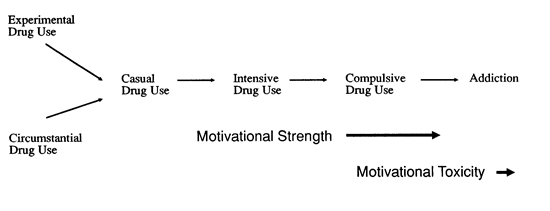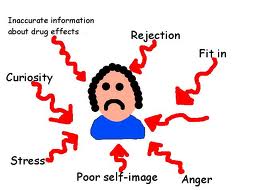| |
Addiction also
referred as substance dependence is a chronic,
relapsing disease affecting the brain’s reward,
motivation, and related systems. People struggling
with addiction are unable to control their actions
or make rational decisions about their behavior,
even in the face of negative consequences.
Compounds and experiences with addictive potential
activate the brain’s reward circuitry. These
triggers are also called reinforcers because the
pleasurable feeling we get from them makes us more
likely to engage in them again. Both alcohol and
illicit drugs are powerful reinforcers, and cause
the release of the neurotransmitter dopamine in the
brain’s reward system. Repeated activation by these
compounds changes the brain’s reward system
structurally and chemically, and produces behaviours
like bingeing,escalating use, and symptoms of
withdrawal when the drugs are taken away.
Addiction is any repeated behavior,
substance-related or not, in which a person feels
compelled to persist, regardless of its negative
impact on his life and the lives of others.
Addiction involves:
1. Compulsive engagement with the behavior, a
preoccupation with it;
2. impaired control over the behavior;
3. Persistence or relapse, despite evidence of harm;
and
4. Dissatisfaction, irritability or intense craving
when the object be it a drug, activity or other
goal—is not immediately available. Compulsion,
impaired control, persistence, irritability,
relapse and craving—these are the hallmarks of
addiction.
—any addiction. Not all harmful compulsions are
addictions, though: an obsessive-compulsive, for
example, also has impaired control and persists in a
ritualized and psychologically debilitating behavior
such as, say, repeated hand washing. The difference
is that he has no
craving for it and, unlike the addict, he gets no
kick out of his compulsion.
Addiction is a process based in altered functioning
of the reward and motivation systems of the brain.
It can manifest in many ways, but historically
addictions fall under two categories.
This includes dependence on any of the following:
Tobacco
Alcohol
Street drugs
Prescription drugs
Although less well studied, many behaviors appear to
have reinforcing properties, and may involve
excesses related to:
• Gambling
• Food
• Sex
• The Internet
• Video Games
• Work
Science shows that substance and behavioral
addictions can occur within the same individual and
that multiple variants of substance or process
addiction can be expressed at the same time. Thus,
people can have multiple addictions with each
addition being active to differing degrees of
severity. Additionally, depression and anxiety
frequently accompany addiction as co-morbid factors.
Substance dependence is a major problem Worldwide,
Pakistan being no exception.
The drugs commonly used in Pakistan are cannabis,
opium, alcohol, codeine, heroin and many
tranquilizers. United Nations Office for Drug and
Crime [UNODC], 2013) data revealed that about 6.7
million substance dependents with age range of 15-64
found in Pakistan. ,one in every 27 persons in
Pakistan is using drugs while nearly 25% of the
youth population is involved in some form of drug
abuse in Pakistan, opiate users are about 1% which
is also very high prevalence.
Drug abuse is most prevalent in Khyber-Pakhtunkhwa
where 11% of the population uses drugs, followed by
Sindh where 6.5 per cent of the population is drug
addict. In Baluchistan, almost five per cent
population uses drugs while in Punjab, 4.8 % of the
population is drug addict.
Cannabis (Charas) is the most commonly used drug in
Pakistan; with Almost 5.8 per cent of the adult
population is addict of cannabis. Opiates namely
opium and heroin are used by almost one per cent of
overall drug users. There are 420,000 people who
inject drugs in Pakistan, which represents 0.4%
population. Non-medical use of tranquilizers and
sedatives is higher among women.
Young people are more susceptible to drug use. They
often talk about the “highs” but may not be aware of
the many “lows”. The widespread availability of
drugs in Pakistan is making it easy for them to be
addicts. Drug addiction among the youth is killing
them morally and socially as well psychologically
and even physically.
The reason why the number of drug addicted people
especially youth is increasing alarmingly in
Pakistan is that the drug cartels in the country are
fully backed and supported by the powerful and the
wealthy who have got ample influence. Moreover,
apparently, police and drug mafia are colluding.
Moreover, easy availability of narcotics and
psychological effects of violence are also playing
part. Children who have suffered violence in their
life or who have undergone a traumatic experience
turn to drugs to forget about the loss.
WHAT ARE THE CAUSES OF DRUG ADDICTION
Majority of drug addicts usually start with soft
drugs like ‘chhaliya’, ‘gutka’ and ‘pan’ and then
move to the hard drugs like heroin, opium and
cocaine etc. The purchase of drugs or alcohol by
young people is usually through dealers or ‘agents’,
who are just a phone call away. Their numbers are
distributed widely at hostels. In Pakistan, users
can get up to 20 Charas cigarettes only for Rs1400.

 |
|
The drug abuse is
often linked to factors such as risk taking
behavior’s that may involve experimenting
with narcotics, smoking and alcohol, social
isolation, stress, anxiety, depression, peer
pressure (bad company), modern life style,
hippy culture, unemployment, excessive
pocket money by parents and lack of
supervision and attention, the desire for
social acceptance, boredom, curiosity, just
to feel good, weak religious belief and lot
of free time, easy access to drugs at low
prices, existence and presence of drug dens,
to heighten sexual pleasure, to overcome
frustration and or tragedies, use as pain
medication and fashion. |
Physical health and sexual
health of addicts weaken so rapidly that a young man
of thirties looks an old man of over-sixties. “Drug
use in general leads to a number of health problems,
such as malnutrition, apathy, menstrual
irregularities and irregular heart rhythm and
premature death.” some of the physical effects of
drugs might sound nice but they do not last long.
Many people get depressed and start feeling sick.
There is economic breakdown of family, loss of
self-confidence and will to work, loss of job,
indulgence in crimes such as theft, and suicidal
thoughts.
Drug addicts are also more prone to accidents and
are at higher risk of HIV/AIDS, hepatitis B & C,
tuberculosis, suicide, overdose deaths and
cardiovascular diseases. Married drug addicts have
high probability of having mentally retarded and
physically handicapped children. Young people who
use cannabis are doubling their risk of psychotic
symptoms like schizophrenia, hallucinations, hearing
voices etc.
Read Treatment Approaches.
Click Here to read about Admission
Procedure. |
|

